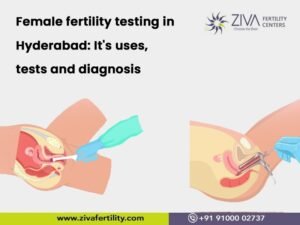What is an Embryo Transfer?
The fruition of an IVF is the day of an Embryo transfer. Couples undergoing IVF wait for this day with great enthusiasm and hope. An embryo transfer is significant because this is the last stage in the IVF process. The fertilized egg that was carefully grown in a laboratory for several days is placed in the woman’s uterus, where it will hopefully implant, become a fetus, and result in the birth of a healthy child. This transfer is carried out by loading the IVF embryo into a catheter, which is then passed through the woman’s vagina and cervix and deposited in the uterus. Anaesthesia is not usually necessary, and at times Valium may be used.
Types of Embryo Transfer
The main principle and the objective are the same. There are various types of embryo transfer based on how the transfer is carried out. Here we will understand the various types of transfer.
Fresh Embryo Transfer
Just as the term implies, when a fresh lab-grown embryo is transferred, it is known as a fresh embryo transfer. In the lab, if more than one healthy embryo is grown, the surgeon will implant an embryo, and the couple can choose to freeze the remaining ones for the future.
Frozen Embryo Transfer (FET)
When the embryo frozen in a previous IVF or a donor egg cycle is transferred, it is Frozen Embryo Transfer. The main reasons for a frozen embryo transfer are:
Medical advice: if the woman is under a lot of physiological stress during the IVF cycle, then the woman’s body cannot simultaneously prepare a beautiful “home” for the embryos to be transferred. In cases of ovarian hyperstimulation syndrome or has elevated progesterone or estrogen levels or has a lining under 7 mm at the time of trigger. Then the surgeon will do a “freeze all cycle,” followed by a FET. The uterus/endometrium is more receptive during the waiting period, and implantation will likely happen.
Earlier stored embryos: In a conventional IVF cycle, ovarian stimulation is done, producing 10-15 eggs. The good news is the production of several high-quality embryos available for transfer. The recommended standard practice is to transfer one or two embryos into the woman’s uterus and freeze all remaining embryos to increase the chance of future pregnancy.
Cleavage Stage Embryo Transfer
The cleavage stage of an embryo means the cells in the embryo are dividing (or cleaving), but the embryo itself is not growing in size. This is mostly a day 3 stage, but may happen on day two or four and are often referred to simply as “day three embryos.” This is done by some fertility experts, as they believe that there’s no substitute for a woman’s uterus and that embryos should be put back into the uterine environment as quickly as possible. Not every embryo can survive until Day 5, so when it is transferred on Day 3, it gets the optimal environment to thrive.
Blastocyst Stage Embryo Transfer
A blastocyst is an embryo which develops into a layered sphere of cells encircling a fluid-filled cavity with a dense mass of cells grouped. There are 60 to 120 cells in a blastocyst. Blastocyst formation happens on day five but may happen on day 6, 7, or even 8. A blastocyst embryo is more “special” than an early-stage embryo. The probability of being genetically normal, and leading to a live birth is higher in a blastocyst than in a cleavage-stage embryo. The advantage of this is that an embryologist can better select embryos with a higher probability for continued development. An embryo at this stage can also be genetically tested before the transfer, which can help reduce the risk of miscarriage and avoid any known genetic disorders.
Single Embryo Transfer (SET or eSET)
This is also known as Elective Embryo Transfer. The embryologist will transfer only one embryo into a woman’s uterus. The risk of multiples is reduced, and a very similar rate of pregnancy is maintained. With reduced risk and a similar pregnancy rate, eSET has quickly become the gold standard for transferring embryos with an IVF procedure.
The surgeon can do a Fresh or Frozen Embryo Transfer. In that, they can choose between Cleavage Transfer or a Blastocyst Transfer.
In most cases, an IVF often results in many embryos. If the couple wants a child immediately, they could do a fresh Single Embryo Transfer followed by a Frozen Embryo Transfer years later using the embryos created in the same IVF cycle.
Timeline of an Embryo Transfer
The timeline is not fixed as it depends on an individual’s unique cycle and is governed by many factors. These decisions are made keeping, given these factors, which sets the trajectory for the next step of the IVF cycle. The day of the embryo transfer is the final stage of an IVF cycle, and the day is highly variable. We recommend that the patients not get attached to any specific calendar or timeline during their own IVF or FET cycle. The day of transfer is decided based on the day of the egg retrieval and the embryo’s developmental stage, and they are both indeed variable. If the cleavage-stage transfer is down, it is performed on the third day of egg retrieval, and blastocyst-stage transfers typically happen five or seven days after the retrieval.
Like a fresh transfer, each Frozen Embryo Transfer is customized to the intended parent’s cycle, depending on their lining development and response to medications (if used). The day of the embryo transfer is ultimately dependent upon the day on which progesterone is started:
- Cleavage embryos are transferred four days after the start of progesterone.
- Blastocyst embryos are transferred six days after the start of progesterone.
What happens during an Embryo Transfer?
Embryo transfer is done in a sterile designated room at the fertility clinic. Your doctor and a nurse of your embryologist will be with you. Anaesthesia is not necessary, but doctors will give you a muscle relaxant or Valium to calm nerves and relax the smooth muscles of the uterus. An embryologist will load the embryo into the transfer catheter, and a speculum is placed into the vagina to allow visualization of the cervix for cleaning. Using ultrasound guidance, the catheter is placed through the cervix and into the uterus, and the embryo is gently deposited into the uterus, where it hopefully implants. The patient experiences minor discomfort when the speculum is inserted, or the catheter is passed through the cervix.
After the transfer, the patient rests for about 15 minutes. Follow-up instructions are given, and a pregnancy test is scheduled ten days post-transfer.
Post Embryo Transfer care and precautions
After the embryo transfer, there is not much medical care needed. A woman has to take rest and relax. Try to do your favourite activities and spend time with your loved ones. Within 72 hours after embryo transfer, implantation occurs. Complete bed rest is unnecessary, but be as stress-free as possible and restrict from strenuous exercise and sex. It will take two weeks to get a confirmation of pregnancy, and during this period, maintain a positive outlook and find ways to relax and connect with your partner. Avoid extreme temperatures, so no hot baths, yoga, saunas, heating pads, or electric blankets. This will raise the temperature of your uterus and should be avoided.
We at ZIVA Fertility Center do all types of embryo transfer. We will decide based on the individual factors of the couple. The day of embryo transfer is a happy day for the couple and the treating medical team. Please visit our website https://zivafertility.com/ or contact us at +91-9100002737, +91-9392834024 and info@zivafertility.com.
















